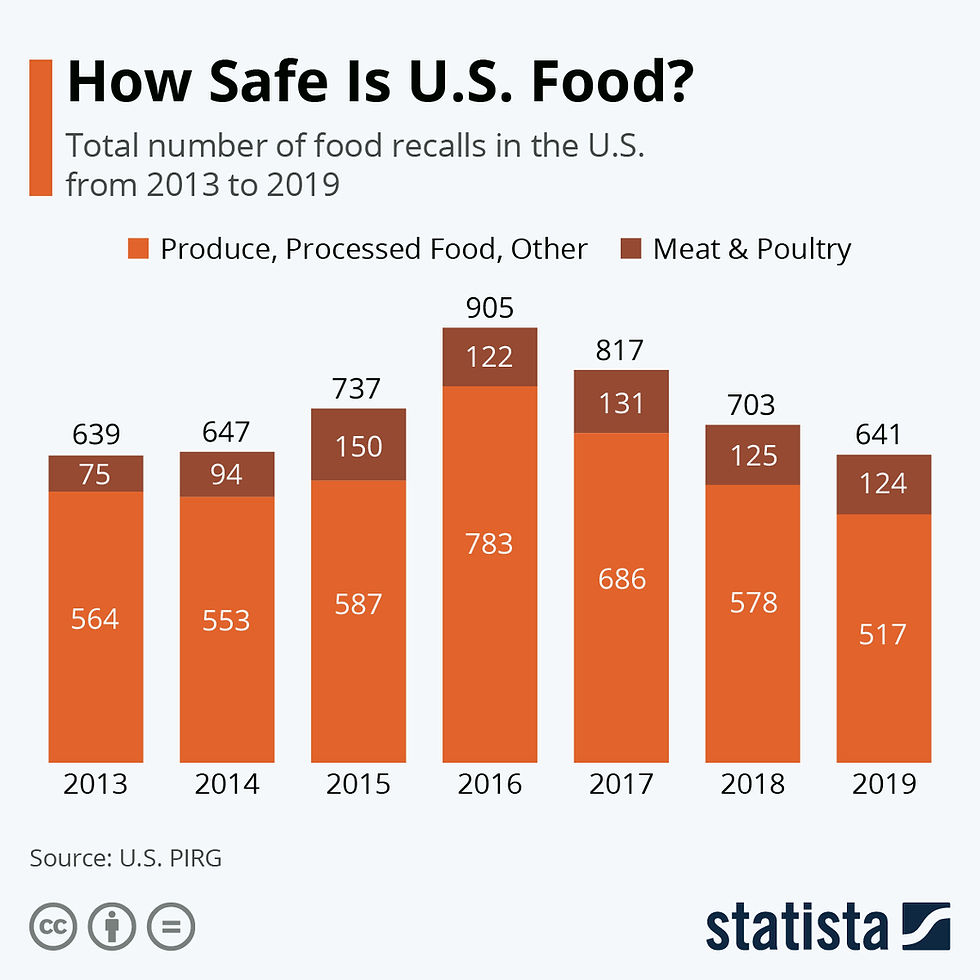Tightening Food Supply Chain to Spike Prices
- agoldson888
- Oct 15, 2020
- 4 min read
The domestic food supply chain is endangered because of a compounding cascade of problems at each link that will result in a food price spike.
Increase of coronavirus infected food workers are causing growing labor shortages at each stage of the food supply chain.
According to government sources, although there is no evidence coronavirus can be transmitted through food, any perception of a tainted food supply could result in panic.
The ever-tightening of the food supply chain from harvesting to processing to transport to endpoint sales to consumers is a disconcerting development that could adversely impact the American consumer as early as late spring or early summer.
Food Supply’s Current State of Affairs
Present-day the nation’s food supply is plentiful across all categories. In certain sectors there is an abundance of perishable foods and milk as articulated in The New York Times article 11 April 2020: Dumped Milk, Smashed Eggs, Plowed Vegetables: Food Waste of the Pandemic. However farmers are forced to destroy them because of structural shortcomings specifically the inability to convert large production to meet smaller quantity packaging at the retail level. A brief summary that explains these issues is as follows:
· Production: Because these perishable foods are for businesses and schools, the quantities produced and type of packaging required are far greater than for consumers. Retooling the machines for the consumer market will require millions in investments.
· Alternate sources: Food banks have limited refrigeration capacity and exports are not feasible and cost prohibitive because of cross-border constraints because every country is trying to handle the pandemic.
Food Supply Chain’s Links Under Strain
The number of all workers infected with Covid-19 virus is growing. For those in professions in which social distancing at work and/or in the home are problematic, the rate of infections is greater.
The New York Times article 9 April 2020 Poultry Worker’s Death Highlight Spread of Coronavirus in Meat Plants reported the increasing number of sick food industry workers because of the Covid-19 virus as well as walkouts protesting the lack of safety gear and cleaning supplies. These are low wage earners who intimately handle our food through cutting, deboning and packaging. For this reason many food processing plants throughout the country owned and operated by the largest companies in the industry such as JBS USA [OTCMKTS: JBSAY], Tyson Foods [NYSE: TSN], Cargill are temporarily shut down for disinfecting.
A descriptive overview of the increasing cascade of risks to the food supply chain can be viewed below in the “farm-to-table” summary:
1. Fewer farm workers and laborers [mostly from Mexico] to harvest labor-intensive work because of stricter visa requirements and the risk of higher infections because of the nature of the work and crowded housing that cannot adhere to social distancing.
2. Fewer food processing workers because of Covid-19 illness.
3. Fewer plants in operations because of shutdowns for cleaning which means less total nationwide food processing.
4. Fewer truckers, an older demographic [55 is the average age] that is susceptible to the Covid-19 virus, to transport goods.
5. Fewer trucks because of potential lack of spare parts because of limited imports from China and domestically because of vehicle plant closures.
6. Fewer food markets open, corporate and independently owned, because fewer workers are willing to work in a high-risk environment even with safety equipment.
Food Quality Risk
In addition to the aforementioned fundamentals, the catalyst driver for a spike in food prices may occur as a result of whether Covid-19 infected food processing handlers can pass along this virus to the food supply. In the previously indicated New York Times article Poultry Worker’s Death Highlight Spread of Coronavirus in Meat Plants, an unnamed government official stated, “There is no evidence that the coronavirus can be transmitted through food, but public health experts have advised consumers to wipe down packaging because the virus could survive on those surfaces for days.”
Despite assurances from government officials, the scientific community is learning something new about this insidious virus daily.
The food quality risk is compounded by the following report How Safe is US Food? 22 January 2020 by PIRG [“Public Interest Research Group, a confederation of U.S. and Canadian non-profit organizations that employ grassroots organizing and direct advocacy for change”] and presented by Statista, an online statistical service.

The hidden risk can be found in the report’s description on the data. To paraphrase the report’s further explanation (the full explanation can be accessed through the Statista link), is that 1 in 6 Americans contracts a foodborne illness annually. Furthermore although recalls have fallen since 2016, hazardous meats and poultry recalls (Class I) have increased 85%, which refers to foods that pose serious health risks.
This begs the question: with Covid-19 running rampant particularly in a labor-intensive sector, to what extent is America’s food supply reasonably safe?
Recommendation
Food prices will increase as the domestic food supply tightens for the aforementioned reasons notably perishable items, meat, pork and poultry. I project that the food supply chain disruptions will be uneven and quite volatile throughout the late spring and summer which is why such an investment is more suitable to the intrepid, quick & nimble investor.
For these reasons I recommend investments through the Chicago Mercantile Exchange (CME) specifically livestock.
[Originally published 16 April 2020]
Copyright 2020 Cerulean Council LLC
The Cerulean Council is a NYC-based think-tank that provides prescient, beyond-the-horizon, contrarian perspectives and risk assessments on geopolitical dynamics and global urban security.




Comments